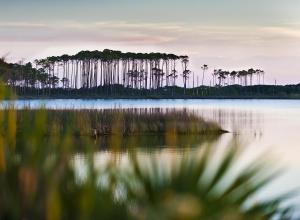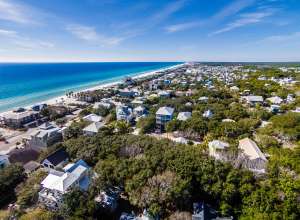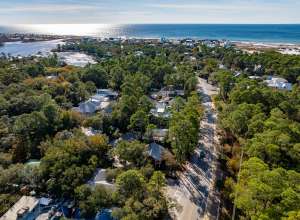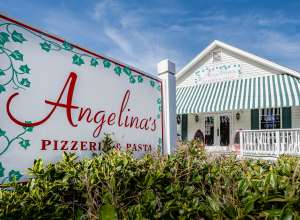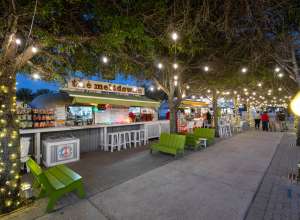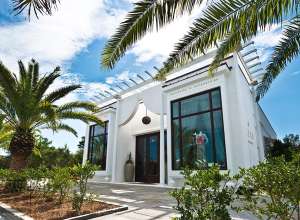Coastal Dune Lakes Documentary Continues at Escape To Create
April 10, 2014 by Elam Stoltzfus

It was wonderful to come back to Walton County for an extended period of time earlier this year. First, with Escape To Create as an Artist in Residence at Seaside, and now returning on my own to capture more moving images for this documentary story. Each working visit affirms the importance to showcase the Coastal Dune Lakes of Walton County.
These moments of "being there" to observe the morning sunrise, watching the patterns of light change through the day and saying goodbye to another outdoor experience as the sun sets bring together a collage of visual vistas. Its been an honor to listen to the stories and learn about the history, looking at the details and hearing about the future of the Coastal Dune Lakes.
After a two short weeks at home and a trip to south Florida, I arrived back at Seaside on Feb. 16 to work on the Coastal Dune Lakes documentary along with interacting with a new group of Escape to Create artists (click here for my first blog with more info about the Escape to Create program).
Moss Below an Oak Tree at Camp Helen State Park (Image: Elam Stoltzfus)
Moon over Grayton Beach (Image: Nic Stoltzfus)
Unconnected Outfall at Western Lake, Late January (Image: Elam Stoltzfus)
During the first part of my time with the program in January there was cold, cold weather—so much that many bridges in the Florida Panhandle were closed for a few days. The area came to standstill. I made good use of my time by having coffee with folks and taking time to discuss the dune lakes project.
This lull in production created a full schedule of on-camera interviews for the project during my second visit with Escape To Create. Having the opportunity to interview a group of experts is such an honor, and every time I interview people it is a chance for me to listen and learn from other peoples’ experiences. Interviews are partly investigative journalism and partly about building relationships. The interviews I did in February are the foundation for the documentary story. Here is the list of people who we interviewed, a bit about who they are, and a quote from their interviews:
The lakes are kind of like children. You can’t really have your favorites. I love them all so much and they all have such a special appearance and special emotion. I like Western Lake over at Grayton Beach State Park. Just because the peace and quiet and all the wildlife that live there. I have some special memories of that. One morning it was a Sunday morning really early and I got up to shoot photographs a couple of years ago as I was working on the book, and I was on my bike with the camera and I heard a singing voice.
The park was totally empty, and I heard a voice and it sounded like a monk doing some sort of vocalization. So, sure enough, in that building that is out there at Western Lake at Grayton Beach State Park there was a man doing his vocal practices on a Sunday morning, and it felt like such the sanctuary because here I was out there totally peaceful and quiet with just the birds, the herons, and then I heard this man’s voice on a Sunday morning. And I was not at church, but I felt like I was at church just for being out there. So little events like that really give you a great connection.
–Ginger Sinton, photographer/journalist and author of Rare Coastal Dune Lakes: Biodiversity and a Sense of Home on 30A
My first trip out of town with my now-husband Kenny was to Destin, Florida. And while we were there someone said, “You really want to see something beautiful? Drive east from here.” We drove down 98, we got to 30A, and we turned down 30A and I just couldn’t believe it. Grew up in New Jersey, near the shore, took a look at the beaches—it is just easy to love what you see down here because it is so beautiful.
And as we drove down we started to see these lakes. And I thought, “Wow, isn’t that cool. I have never seen anything like that. Never seen lakes so close to the water.” And then as time went on we ended up buying property down here, built down here, and I got involved with community work. And that is when I first learned—I knew that they were beautiful, I knew they had this interesting thing that happened with the outfalls, but it wasn’t until I got involved with the community work that I realized, “Wow, these are really special.”
–Jacquee Markel, a local civic-minded citizen and environmental activist
The Emerald Coast in general is a treasure, it is a beauty and each section of the Emerald Coast has something that makes it special… we have a lot of folks who come because of the things that the coastal dune lakes provide. Birdwatching, natural trails, things like that that are around the lakes…
–Jim Bagby, Executive Director of the South Walton Tourist Development Council
…I describe them as 15 jewels. One is a diamond, one is a ruby, one is a sapphire. They are all different. And they all have their different qualities and they all are set in a different setting. In other words, they are almost like delicately set in [the dunes]; almost like a ring would be. High white-white, the highest white on the Munsell Scale is the color of the sand here. So white-white dunes…the sky is just this great big sky that is…as blue-blue as you can see.
And the water is emerald green. So it is almost like you are looking at a field of jewels. And the further you go down 30A, you know, you might see a pearl and then the sun glistens off of the diamonds. It is really one of the more spectacular things that you will ever see. Especially if you drive down here and you are driving down 30A and you come to the curve where Western Lake is and it just opens up and most people pull off the side of the road. Their mouth drops and the sun is going down and the colors are purples and greens and blues and lavenders–it is one of the most spectacular places that you will really ever see.
–Cindy Meadows, Walton County Commissioner, District 5
I feel calm usually when I am there. I feel peaceful and I think that is what really is special about them being right there on the beach. You know the ocean is always moving, the gulf is just moving, moving, moving and you can watch that from a body of water that is completely still. It is not always still, but often. And I think that leads to a very introspective, contemplative kind of space.
–Sarah Schindele, Ph.D, Grant Coordinator for the Choctawhatchee Basin Alliance
A dune lake, for me, is a place of peace. I like to go out there in the mornings before the fog lifts off the ground and just be there next to the lake and take in the quiet and just see what happens. You never know what is going to happen. Sometimes an alligator comes up, sometimes an osprey or an eagle flies over. You know if it is in the spring migration you get migratory birds coming through and it is always different. The lake has its own character. And each one has its own character.
–Jeff Talbert, Park Service Specialist, Topsail Hill Preserve State Park
It is a very delicate system and I am amazed at how just the lake being closed up to any saltwater influx has changed the organisms of the fish in the lake. When that lake is on a routine basis of opening and closing you can catch the primary saltwater/brackish water fish are, you know, the redfish, trout, and speckled trout, and flounder. But then it gets highly freshwater. Now we have a creek coming into our cove so it can really freshen up quickly, but you can then catch bass and brim, but there are alligators in the lake. I have caught bonita, barracuda, and octopus in the lakes after storms. It is just amazing the variety of fish, it is just fascinating the ecosystem, and I have never seen that anywhere else I have ever lived.
–Edmond Alexander, Medical Illustrator and resident along Western Lake
We need to protect the lakes, we need to protect them from motorized vehicles, we need to protect the bike trail from motorized vehicles. We are in a protection mode and we need all of the support that we can get to keep the beauty, the cleanliness, and the overall charm, ambience, whatever your word is, to keep the enhancement of this community going. One of the points of the scenic highway designation is that is a scenic highway enhances a traveler’s journey. So, if you are going to enhance a traveler’s journey you need to keep it pristine and clean and agreeable. And no billboards and lots of beauty to absorb and look at and share.
–Claire Bannerman, 30A Scenic Highway Chairperson and advocate
We typically see sand dunes from the beach side. And over on the other side of the sand dunes, at least in this area, in some parts, are these lakes. Some small, some medium-sized; dark in color, tea-color or coffee-color. Brackish water.
What I like about them is that if you are paddling on the lake you get to see the backside of the sand dune and it is a different perspective. And, of course, on the other side of that sand dune is the Gulf of Mexico. Sometimes you can catch a glimpse of it, sometimes you don’t see it at all. But you know it is on the other side.
–Jack Davis, Ph.D, University of Florida professor of environmental history
[When I go out on the lakes] I feel a sense of peace and a sense of freedom. I love to get out on my paddle board particularly in the late afternoon as the light is changing and it is just so beautiful and nature is so restorative. I love to get out there and to think and reflect and just to enjoy the incredible beauty.
–Susan Paladini, Manager for the Coffeen Nature Preserve and Four Mile Village
[A coastal dune lake] is near the coast and it has sand dunes all around it and I’ve learned this in the last 20 years or so that some of them have a great deal of saltwater in them and others are literally like Fuller Lake is and almost free of salt. And so they are all different and, as far as I know, they are only fed only by the weather. No springs or anything like that that I know of. And now I know how rare they are. I kinda figured all of Florida was like that until I got around all of Florida and it is not so.
–Ed Coffeen, Nephew of John and Dorothy Coffeen (founders of the Coffeen Nature Preserve)
Currently all the interviews have been transcribed. Now we begin writing a series of short video segments and start editing these stories together. We will be posting these stories bi-monthly on the Coastal Dune Lakes website, Facebook, and the CDL YouTube channel. Stay tuned.
https://www.coastaldunelakes.org


